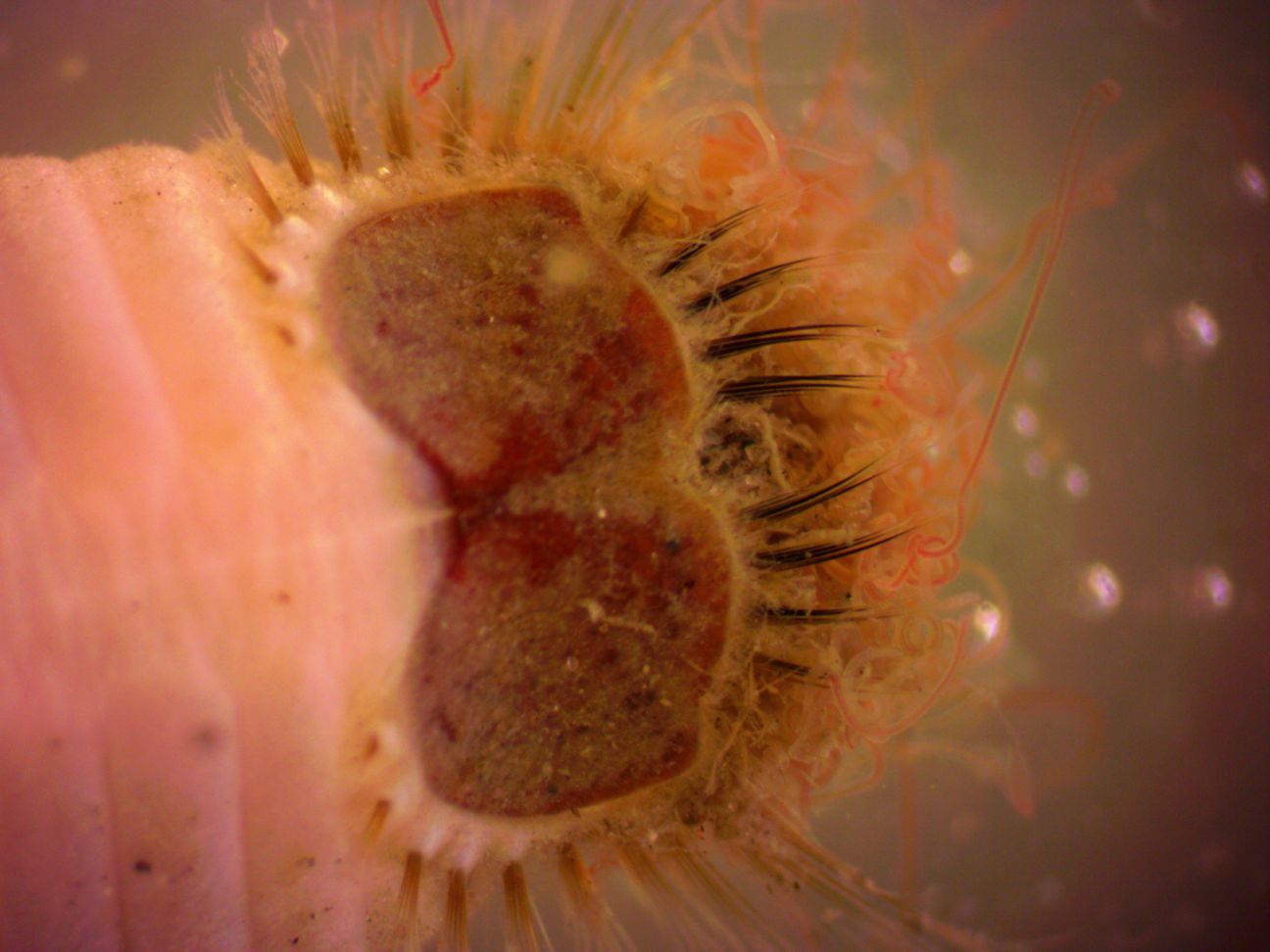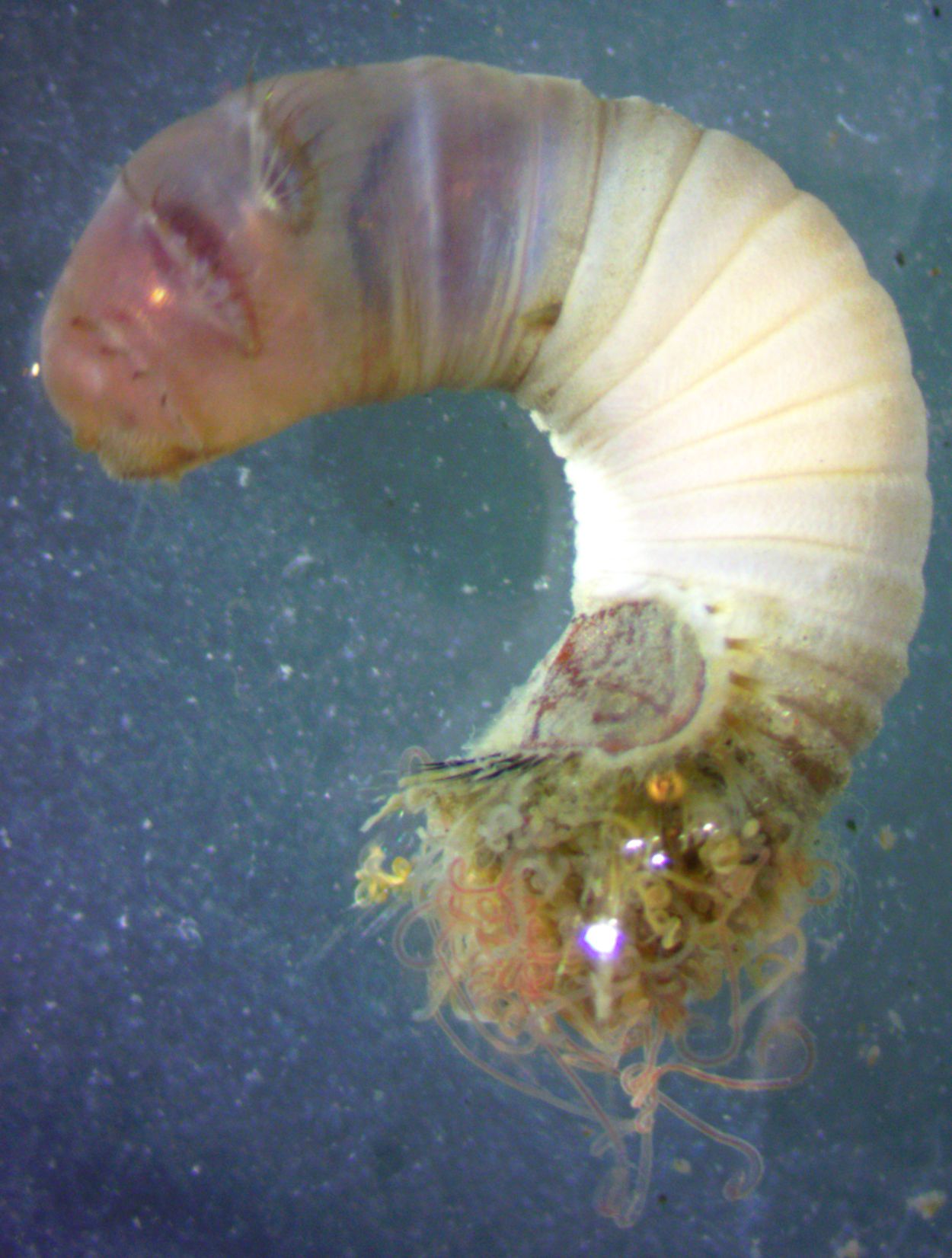Sternaspis affinisCommon name(s): Ground-digger dumb-bell worm, mud-owl, gooseberry worm |
|
| Synonyms: |  |
|
Phylum Annelida
Order Terebellida
Family Sternaspidae
|
|
| Sternaspis affinis, 1 cm long, ventral view. Anterior is to the left and the posterior ventral shield, chetae, and gills are to the right. The introvert is slightly extended on the left, exposing the genital papillae which are between thoracic segments 7 and 8. Collected from mud at 9m depth in Burrows Bay. | |
| (Photo by: Dave Cowles, July 2019) | |
Description: (from Sendall and Salazar-Vallejo, 2013):
Description of Family Sternaspidae: Sternaspidae is a worldwide polychaete family with just a few species. They are typically subtidal, marine, non-selective infaunal deposit feeders. They may live in rocky or coarse sand, shell hash, soft mud, or deep-sea clay. They have been collected down to depths of >4000 m but are more abundant < 200 m. They bury head-first in the sediment, with only the posterior gills exposed at the sediment surface. They can invaginate or evert the first several sections of their body (called an introvert, consisting of the head and 6 segments of thorax). Behind the introvert is a (slightly?) constricted region composed of thoracic segments 7 and 8. Behind this is the abdomen, which may be all that is visible when the animal has invaginated its introvert. The abdomen may be missing chetae on most of the anterior segments in adults, but it has a distinctive, relatively hardened, caudal shield on the posterior ventral surface. Abundant chetae surround the shield. The gills are on the posterior end, dorsal to the anus. Diagnosis (from Sendall and Salazar-Vallejo, 2013): Body peanut-shaped. Introvert with falcate, tapered or subdistally expanded hooks. Segments 7–8 constricted, with genital papillae protruding ventrally from between them. Pre-shield region of the abdomen with 7 or 8 segments. Ventro-caudal shield usually stiff, often provided with radiating ribs and concentric lines, rarely flexible. Marginal shield chaetal fascicles include lateral and posterior chaetae, sometimes peg chaetae or additional delicate chaetae present. Branchiae coiled, abundant filaments, emerging from two lateral dorsal plates, near the anus, or directly from the body wall. Additional, thinner coiled interbranchial papillae present.
Description of Genus Sternaspis (from Sendall and Salazar-Vallejo, 2013): The hooks on the introvert are tapered. The shield ornamentation incluses ribs, concentric lines, or both. The anterior abdomen has 7 segments. (The name Sternaspis means "breast shield", due to an early investigator "Otto" not realizing that the shield was on the back of the body, not on the front.)
Sternaspis affinis (rom Sendall and Salazar-Vallejo, 2013): Shield features: The shield has both shallow ribs and concentric lines. The anterior margins are rounded and the anterior depression is deep. The lateral margins are rounded, and the fan (the mid-posterior ribbed portion) is crenulated. The shield has 10 lateral shield chetae in an oval pattern and 5 posterior shield chetae in a line. Peg chetae (short chetae on the margin of the shield between the lateral and posterior chetae) are also present. As with other members of the family, the animal is peanut-shaped when the introvert is retracted and only the abdomen is visible.
How to Distinguish from Similar Species: Currently, this is considered to be the only species from this family present in the Northwest Pacific. the S. scutata mentioned in the Kozloff key is from the Mediterranean Sea and S. fossor mentioned in Lamb and Hanby (2005) and Carlton (2007) is from the northwestern Atlantic.
Geographical Range: Southern Alaska to southern California.
Depth Range: 10-at least 409 meters
Habitat: Infauna in soft bottoms. The individuals pictured here were found in mud.
Biology/Natural History: These worms are infaunal direct deposit feeders, which feed with their head down and their entire body except for their posterior gills buried in the mud. Some have speculated that the shield serves as a defense for the posterior part of the body which is closest to the surface, but since the shield itself is buried this seems less likely. A series of internal muscles attaches along the outer perimeter of the shield (which may be flexed to a certain extent) so maybe the shield simply serves as an anchor point for those muscles, or anchors for the chetae for defense. Although they look chitinous, neither the shield nor the chetae are made of chitin. Lowenstam (1972) concluded that the shields are composed of 33% ferrous oxide, 22.4% phosphorus pentoxide, 3.4% calcium oxide, 2.8% magnesium oxide, 0.1% barium oxide, and 0.04% manganese oxide; and the chetae may contain calcium phosphate.
Sternapsis species have separate sexes. Their larvae spend only about 2 days as plankton before settling.
Much more information about the organism can be found in
Sendall
and Salazar-Vallejo (2013)
| Return to: | |||
| Main Page | Alphabetic Index | Systematic Index | Glossary |
References:
Dichotomous Keys:Carlton, 2007 (Tentatively as Sternaspis fossor)
Kozloff, 1987, 1996 (as Sternaspis scutata)
General References:
Lamb
and Hanby, 2005 (as Sternaspis
fossor)
Scientific Articles:
Lowenstam HA., 1972. Phosphatic hard tissues of marine invertebrates:
Their nature and mechanical function, and some fossil implications.
Chemical
Geology 9: 153-166 doi: 10.1016/0009-2541(72)90053-8
Sendall,
Kelly, and Sergio I. Salazar-Vallejo, 2013. Revision
of Sternaspis
Otto, 1821 (Polychaeta, Sternaspidae) Zookeys, 2013; (286) pp 1-74
Web sites:
General Notes and Observations: Locations, abundances, unusual behaviors:

This dorsal view shows the posterior
gills
to the right and
the invaginated
introvert
(anterior)
on the left.
Note the red, hemoglobin-filled blood in the gills
and the whitish-colored filaments that are interspersed with
them.
In life, the gills
move in a writhing motion, likely to facilitate blood movement and gas
exchange. For videos of this movement click here
and here.

A close-up view of the ventral
shield, chetae,
and gills
at the posterior
end

This ventral
view
of the anterior
end
shows the genital papillae.
These papillae
project
from between the 7th and 8th thoracic
segments. When the animal is fully retracted, only the abdominal
segments are visible so the papillae
cannot be seen. Since they are visible, the anterior
introvert
(head and
thoracic
sections) is
slightly protruded but the anterior
6 thoracic
segments and
the head are still invaginated
inside.

In this photo the introvert
(head and thoracic
segments)
is mostly extended, doubling the animal's length to 2 cm. Note the 3
sets
of parapodia
with
chetae
on some of the
thoracic
segments. Click
here
for a movie
of the animal extending its introvert.
Authors and Editors
of Page:
Dave Cowles (2018): Created original page
CSS coding for page developed by Jonathan Cowles
Salish Sea Invertebrates web site provided courtesy of Walla
Walla University